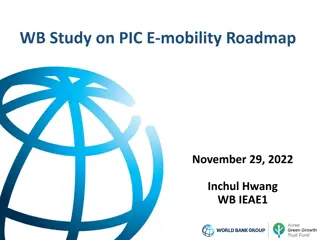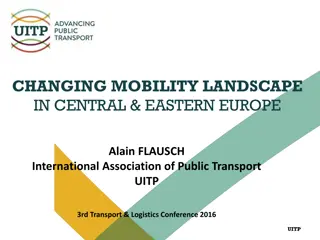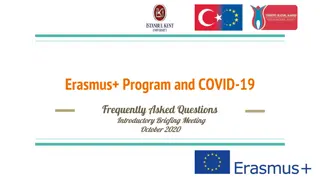The Share Percentage System for Mobility in ASEM Context
Exploring the Share Percentage System for mobility in the context of ASEM, this article emphasizes the importance of common credit transfer systems and lessons learned from EU-SHARE. The system is based on aligning national qualification frameworks, comparability of study program learning outcomes, and fixed mobility percentages determined by HEIs pre-Learning Agreement. Key principles include 100% qualification representation, credit recognition, and student outcome validation for graduation.
Download Presentation

Please find below an Image/Link to download the presentation.
The content on the website is provided AS IS for your information and personal use only. It may not be sold, licensed, or shared on other websites without obtaining consent from the author. Download presentation by click this link. If you encounter any issues during the download, it is possible that the publisher has removed the file from their server.
E N D
Presentation Transcript
CREDITS AND GRADES: CORNER STONES FOR ASEM-MOBILITY A PLEA FOR A PRAGMATIC APPROACH FREDERIK DE DECKER, HEAD INTERNATIONAL RELATIONS OFFICE 2
PART I: TOWARDS A COMMON CREDIT TRANSFER SYSTEM FOR INTRA- ASEAN AND ASEAN EU MOBILITY? 3
THE SHARE PERCENTAGE SYSTEM FOR MOBILITY: BASED ON QF S The SHARE mobility percentage system is based on the following principles: Comparability of the levels of qualifications at the Home and Host HEIs verifiable via the alignment of national qualification frameworks and/or regional qualification frameworks (AQRF for the ASEAN region; QF for the European Higher Education Area for the EU) Comparability of the levels of the study programmes learning outcomes between Home and Host HEIs verifiable on the basis of the descriptions of the programmes and courses available at the HEIs 5
THE SHARE PERCENTAGE SYSTEM FOR MOBILITY: BASIC PRINCIPLES A qualification represents 100% of a programme s outcomes and in order to graduate, a student must demonstrate he/she has attained and validated the outcomes and been assigned the total number of associated credits The SHARE mobility percentage system for the recognition, transfer and conversion of credits takes into account the weight of the students mobility outcomes (= a percentage) in their full study programme at their Home HEI The applied mobility percentage is fixed by HEIs before the Learning Agreement is signed 7
THE SHARE PERCENTAGE SYSTEM FOR MOBILITY 8
QUESTIONS FOR DISCUSSION Is the SHARE percentage system for mobility , based on existing QF s and the use of learning outcomes applicable in the ASEM-context? Are all countries/HEIs equally ready for it Are Qualifications Frameworks in place? Are programmes described in terms of learning outcomes? What about the instruments used, e.g. learning agreements: is it realistic in an ASEM context? 10
PART II: GRADE CONVERSION AT GHENT UNIVERSITY: A PRAGMATIC APPROACH 11
GRADE CONVERSION: THE PRINCIPLES European HEIs have different grading scales and passing rates Mobility students have the right to a fair conversion of the grades they ve obtained during a period of study abroad Each HEI should produce a grading table for each degree course within a specific subject area This will help ensure the transparency of the grading culture and the accurate conversion of grades for mobility students 12
GRADING TABLES (GRADE DISTRIBUTION) - Based on number of students that passed - Distribution of the number of students for each passing grade (in percentages) - By ISCED-code (International Standard Classification of Education 13
CURRENT CONTEXT: EUROPE - Many European institutions - Are stuck in 2008 (A-B-C-D-E-F) - Do not use ISCED-codes - Use a pass/fail system - Unlike what is mentioned in the ECTS Users Guides, in the Erasmus Charter for Higher Education Institutions 16
CONTEXT: WORLDWIDE - No consensus on the use of credit system E.g. Three major credit transfer systems are in use in the Asia: AUN ACTS: the AUN ASEAN Credit Transfer System UMAP UCTS: the University Mobility in Asia and the Pacific Credit Transfer Scheme SEAMEO RIHED ACTF: the SEAMEO RIHED Academic Credit Transfer Framework - And certainly no consensus on grade conversion 17
NEED FOR AN ALTERNATIVE, PRAGMATIC APPROACH - Since academic year 2018-2019: introduction of a new system at Ghent University, included in the Education and Examination Code - 5 consecutive steps: preferably step 1, if not possible then 2, if not possible then 3 etc. 18
A 5-STEPS APPROACH Step 1: Grade distribution table with ISCED reference group Step 2: Grade distribution table at the level of the institution / programme / course Step 3: Grade distribution table at country level Step 4: Grade distribution table based on the A-B-C-D-E scale Step 5: No grade distribution table (+ Pass/Fail) 19
1. GRADE DISTRIBUTION TABLE WITH ISCED REFERENCE GROUP - The normal (ECTS Users Guide compliant) system - To be found by means of Egracons (see earlier) or websites/Transcript of Records of partner institutions - Collected available information on a sharepoint-site available throughout the university 20
2. GRADE DISTRIBUTION TABLE AT THE LEVEL OF THE INSTITUTION / PROGRAMME / COURSE 21
3: GRADE DISTRIBUTION TABLE AT COUNTRY LEVEL - Either from egracons - Or: based on our own statistically relevant available data (not so easy ) - Included in Sharepoint site 22
4: GRADE DISTRIBUTION TABLE BASED ON THE A-B-C-D-E SCALE - The pre-2009 ECTS Grading Table (A-B-C-D-E-scale) is still used by many European universities - In essence this is also a (very rudimentary) grade distribution table (and better than nothing) Grade E D C B A Distribution 100% 90% 65% 35% 10% 23
5: NO GRADE DISTRIBUTION TABLE - Very often the case outside the Erasmus+ programme countries - But also still with Erasmus-partner institutions - Advise to the programmes: communicate in advance about the methodology for grade conversion to be used, preferably on the basis of clear agreements with the partner institution 24
PASS-FAIL - Special case = institutions / programmes / courses without grading; just PASS/FAIL - Impossible to translate this in a local grade (although many attempt, but on what basis?) - Proposal (legally possible): use the pass/fail and not give a local grade - Consequence: these courses do not count to calculate a final grade 25
MORE INFORMATION See https://www.ugent.be/nl/univgent/waarvoor-staat- ugent/internationalisering/internationaal/ects.htm 26
QUESTIONS FOR DISCUSSION - What are the obstacles for HEIs in Europe and in Asia to produce grading tables (per ISCED code)? - Can a pragmatic approach be helpful for grade conversion within the ASEM-context? - What do we need to put into place? 27
www.ugent.be Universiteit Gent @ugent instagram.com/ugent Ghent University Frederik.DeDecker@UGent.be 28























